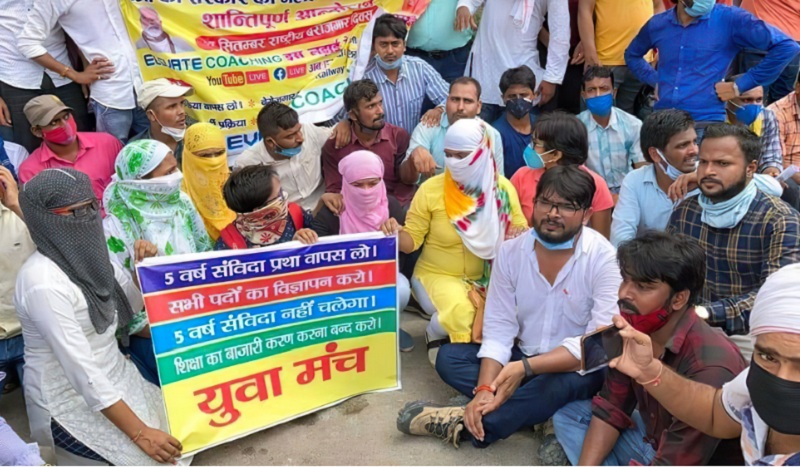By Santosh Mehrotra
The employment rate, or the share of the working-age and youth population finding work, is falling in India.
Our own study, based on an Indian government agency data, however, shows, that this is not the case.
However, that is because of its definitions of what is ‘work’ and what is ‘employment” not being internationally compliant! Work without remuneration (or unpaid family labour, UFL) is called work by ILO, but Indian government treats it as employment. Whichever way one treats it, UFL is the worst form of work.
Since 2004–2005, the overall employment rate in India fell from 42 percent to 35 percent in 2017–2018 before rising again to 41 percent.
The unemployment trend reflects a multi-dimensional crisis faced by India.
India has not been able to take advantage of its demographic dividend which began in the 1980s and is expected to end by 2040. Demographic dividend refers to the potential for accelerated economic growth when the share of the working age population (15 to 64 years) is larger than that of the dependent population (under 15 and over 64 years).
Nations can leverage the demographic dividend offered by their population profiles to boost growth.
If India has to do that, it needs to grow consistently on an average at eight percent per annum.
India was growing at 7.8 percent per annum from 2003 to 2015, reflecting that the benefits of the demographic dividend had begun to materialise. However, from 2014 to 2024, the growth rate fell to 5.8 percent per annum.
No international agency projects that India will grow at anywhere above 6.7 percent per annum between 2020 and 2030. That is already 1.3 percent lower than the desired growth rate.
Moreover, in the last 10 years (2014–2024), India has grown at a rate 2.2 percentage points lower than the required rate of eight percent. Therefore, the pressure is to achieve much higher growth rates over the 2030s.
Slowing economic growth will worsen unemployment.
The share of the working-age population is, however, still increasing but it is not translating into more people joining the labour force.
Out of the about 900 million people in the working-age population, the author’s estimates show, only about 330 million of the 610 million workforce were engaged in non-farm sector jobs in 2023–2024.
About 280 million people were engaged in agriculture and allied sector activities, of which a substantial proportion was unpaid family labour.
About 28 million unemployed educated youth are looking for decent jobs, and about 100 million educated youth (mostly women) are not actively looking for employment.
Moreover, the author’s estimates also show that another 150 million youth are currently undergoing education and training. Hence, the quest for job opportunities has become increasingly urgent as rising unemployment rates exacerbate the challenges faced by under-employed individuals.
Growth slowing down to 5.8 percent per annum between 2014 and 2023–2024 had multiple consequences.
First, the Union government (2014–2024) had inherited an unemployment rate for 15 to 59-year-olds of 2.2 percent. By 2017–2018, this had tripled to 6.1 percent, the highest in 45 years. Youth (15 to 29 years) unemployment also tripled over the same period.
Second, a structural change was underway over 2004–2014 that involved a dramatic fall in the absolute number of workers in agriculture with a rising share of both construction and manufacturing’s contribution to employment and Gross Value Addition.
This structural change was not only interrupted but reversed between 2015 and 2024.
The manufacturing share of GDP had remained at roughly the same level from 1960 or so until 2015. It collapsed thereafter for five years.
Despite the ‘Make in India’ campaign, manufacturing’s contribution to GVA fell from 17 percent in 2014 to 15 percent and then 13 percent by 2022 Ministry of Finance, Economic Survey, various issues.
This share did not begin to recover till the financial year 2024.
Similarly, the author’s estimates show that the share of manufacturing in employment, after rising from 10.5 percent to 12.8 percent between 2004 and 2012, fell to 11.5 percent (2024). This was accompanied by an absolute fall in employment in manufacturing till 2021 — for the first time in India’s post-Independence history.
Third, another dimension of the aborted structural change, which had only seriously gathered momentum after 2004, concerns the share of agriculture in total employment. After falling consistently for the last half century, it actually rose from 42 percent in 2018–2019 to 45.8 percent in 2022–2023 after peaking at 46.5 percent in 2021–2022. The figure stood at 46.1 percent in 2023–2024.
That means the Lewisian transition — surplus of rural labour getting fully absorbed into the manufacturing sector, leading to a rise in both agricultural wages and that of unskilled industrial workers — that had gathered momentum post-2004 was reversed again.
That reversal, till mid-2024, showed no sign of being stemmed, let alone returning to a path that India needs to be on to realise its demographic dividend.
Fourth, to realise the demographic dividend, millions who are joining the labour force must be employed (and in the non-farm sector). This is not happening.
The structural economic crisis (of slower GDP growth) and the employment crisis are monumental enough for a country that has the largest population in the world, exceeding that of China.
However, these twin challenges are compounded by a third: the education crisis.
Access to both school and higher education during the first two decades of the 21st century is generating millions of unemployable school-leavers and tertiary graduates.
Finally, India’s workforce is also rapidly ageing. From around 37 percent in 2016–2017, the proportion of employed people aged forty-five years and higher increased by over 12 points in 6 years to 49 percent.
In 2022–2023, almost half the workforce of India comprised people over 45-years-old. While around 63 percent of the workforce of India in 2016–2017 was below age forty-five, the other 37 percent was above forty-five years. By 2022–2023, the workforce was roughly equally divided between the two age groups.
Correspondingly, the share of youth (aged 15 to 24) in the workforce, already relatively low, has declined.
The employment rate among youth almost halved, from around 53 percent in 2004–2005 to 31 percent in 2017–2018 but recovered to 40 percent in 2022–2023. The fall in employment rate occurred alongside a fall in youth labour force participation rate.
Clearly, the youth are increasingly falling out of the labour force as they are not finding work: they are becoming ‘discouraged workers’.
Note: Author’s estimates in the text are from a forthcoming book, Santosh Mehrotra and Jajati Parida, India out of Work, Bloomsbury, London, 2025.
Santosh Mehrotra is Visiting Professor, Centre for Development Studies, University of Bath, UK and ex-Professor of Economics and Chair of the Centre for Informal Sector and Labour, Jawaharlal Nehru University, New Delhi.















